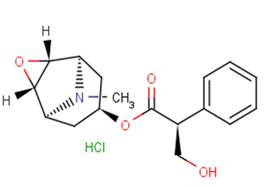
HYOSCINE HYDROCHLORIDE
CAS No. 55-16-3
HYOSCINE HYDROCHLORIDE( —— )
Catalog No. M20466 CAS No. 55-16-3
HYOSCINE HYDROCHLORIDE versus placebo in preventing motion sickness has been shown to be effective.
Purity : >98% (HPLC)
 COA
COA
 Datasheet
Datasheet
 HNMR
HNMR
 HPLC
HPLC
 MSDS
MSDS
 Handing Instructions
Handing Instructions
| Size | Price / USD | Stock | Quantity |
| 10MG | 49 | In Stock |


|
| 25MG | 75 | In Stock |


|
| 100MG | Get Quote | In Stock |


|
| 200MG | Get Quote | In Stock |


|
| 500MG | Get Quote | In Stock |


|
| 1G | Get Quote | In Stock |


|
Biological Information
-
Product NameHYOSCINE HYDROCHLORIDE
-
NoteResearch use only, not for human use.
-
Brief DescriptionHYOSCINE HYDROCHLORIDE versus placebo in preventing motion sickness has been shown to be effective.
-
DescriptionHYOSCINE HYDROCHLORIDE versus placebo in preventing motion sickness has been shown to be effective.
-
In VitroScopolamine blocks nicotinic acetylcholine receptors (IC50=928 μM) and increases the expression of α7 nACh receptors. Scopolamine displays concentration-dependent competition with 0.6 nM [3H]Granisetron, yielding an average pKi of 5.17±0.24 (Ki=6.76 μM). Concentration-dependent competition of fluorescently labeled form of granisetron (G-FL) with Scopolamine gives an average pKi of 5.31±0.09 (Ki=4.90 μM).Scopolamine blocks muscarinic receptors and induces a cognitive deficit.Scopolamine (0.1-3 mM; for 24 hours) induces cytotoxicity, ROS generation and apoptosis of SH-SY5Y cells.Cell Viability Assay Cell Line:Human neuroblastoma SH-SY5Y cell line Concentration:0.1-3 mM (usually 2 mM) Incubation Time:24 hours Result:Exposure to 1-3 mM for 24 hours significantly decreased human neuroblastoma SH-SY5Y cell viability in a dose-dependent manner. In all subsequent experiments, 2 M resulted in 50.6±2.2% loss in cell viability.
-
In VivoScopolamine induces memory impairment associated with attenuation of cholinergic neurotransmission, as well as an increases of processes connected with oxidative stress in the brain. Animal Model:Naive male Swiss mice weighing 20-25 Dosage:1mg/kg Administration: Administered intraperitoneally (i.p.); to measure the memory acquisition processes, Scopolamine was administered 20 min before the pretest; to measure the memory consolidation processes, Scopolamine was administered immediately after the pretest Result:In scopolamine-treated group, there was a significant decrease in the index of latency (IL) value as compared with the saline-treated mice, indicating that scopolamine at the used dose impaired acquisition of memory and learning.
-
Synonyms——
-
PathwayOthers
-
TargetOther Targets
-
RecptorOthers
-
Research Area——
-
Indication——
Chemical Information
-
CAS Number55-16-3
-
Formula Weight339.8
-
Molecular FormulaC17H22ClNO4?
-
Purity>98% (HPLC)
-
Solubility——
-
SMILESCl.[H][C@@]12O[C@]1([H])[C@H]1C[C@H](C[C@@H]2N1C)OC(=O)[C@H](CO)c1ccccc1
-
Chemical Name——
Shipping & Storage Information
-
Storage(-20℃)
-
ShippingWith Ice Pack
-
Stability≥ 2 years
Reference
1.Spinks A Wasiak J . Scopolamine (hyoscine) for preventing and treating motion sickness[J]. Cochrane database of systematic reviews (Online) 2011(6):CD002851.
molnova catalog



related products
-
Jalapinolic acid
Jalapinolic acid is a hydroxypalmitic acid.
-
Isoscutellarein
8-Hydroxyapigenin is a brassinaceous compound derived from the plant Scutellaria baicalensis with anti-inflammatory, antioxidant and anti-influenza virus activity.
-
Kaempferol 3-O-rutin...
Kaempferol 3-O-rutinoside 7-O-glucoside is a natural product for research related to life sciences.



 Cart
Cart
 sales@molnova.com
sales@molnova.com


